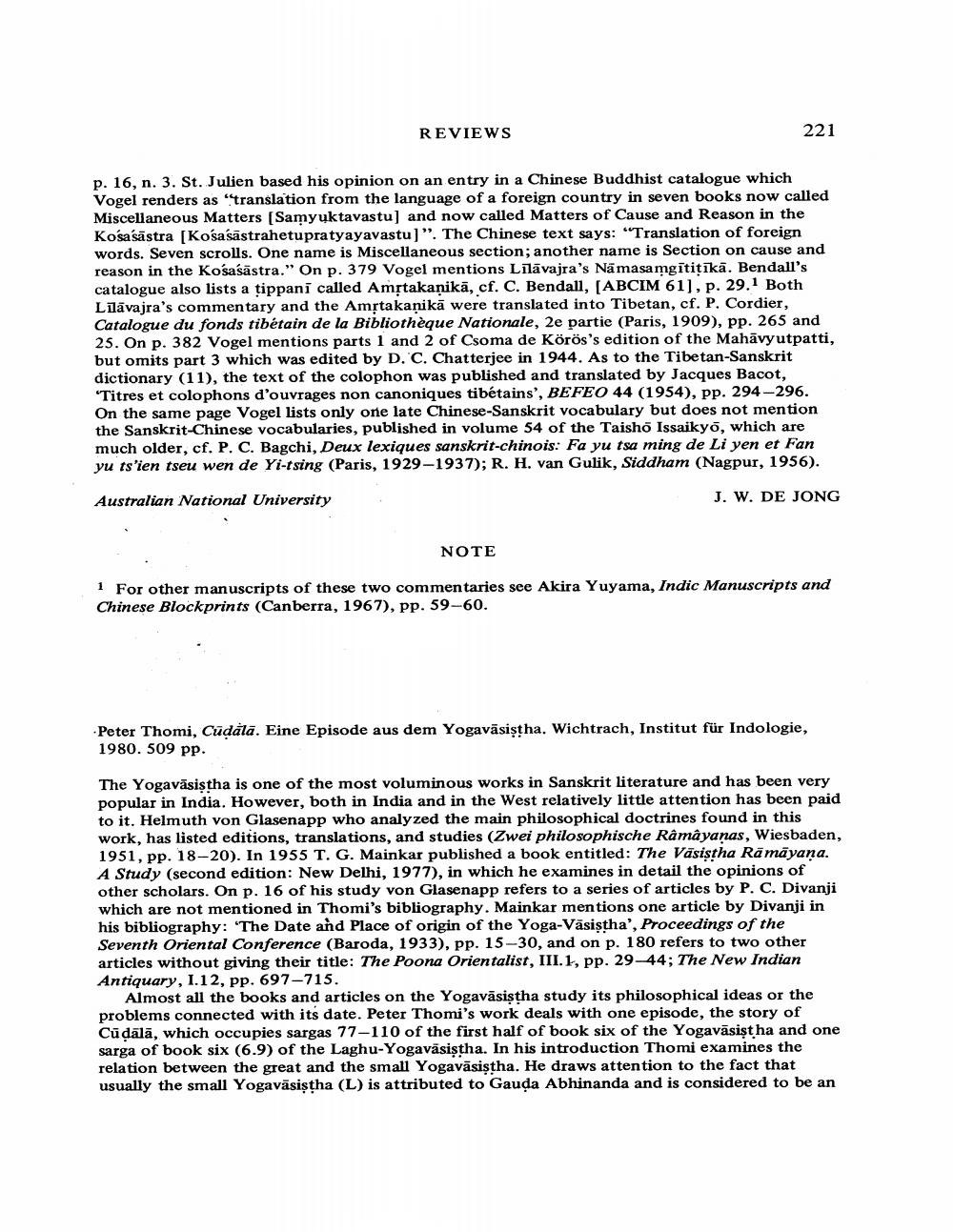Book Title: Book Reviews Author(s): J W De Jong Publisher: J W De Jong View full book textPage 3
________________ REVIEWS 221 p. 16, n. 3. St. Julien based his opinion on an entry in a Chinese Buddhist catalogue which Vogel renders as "translation from the language of a foreign country in seven books now called Miscellaneous Matters [Samyuktavastu] and now called Matters of Cause and Reason in the Kosasastra [Kosasastrahetupratyayavastu]". The Chinese text says: "Translation of foreign words. Seven scrolls. One name is Miscellaneous section; another name is Section on cause and reason in the Kosasastra." On p. 379 Vogel mentions Līlāvajra's Nämasamgītiṭīkā. Bendall's catalogue also lists a tippani called Amṛtakaṇikā, cf. C. Bendall, [ABCIM 61], p. 29.1 Both Lilāvajra's commentary and the Amṛtakanika were translated into Tibetan, cf. P. Cordier, Catalogue du fonds tibétain de la Bibliothèque Nationale, 2e partie (Paris, 1909), pp. 265 and 25. On p. 382 Vogel mentions parts 1 and 2 of Csoma de Körös's edition of the Mahāvyutpatti, but omits part 3 which was edited by D. C. Chatterjee in 1944. As to the Tibetan-Sanskrit dictionary (11), the text of the colophon was published and translated by Jacques Bacot, 'Titres et colophons d'ouvrages non canoniques tibétains', BEFEO 44 (1954), pp. 294-296. On the same page Vogel lists only one late Chinese-Sanskrit vocabulary but does not mention the Sanskrit-Chinese vocabularies, published in volume 54 of the Taishō Issaikyō, which are much older, cf. P. C. Bagchi, Deux lexiques sanskrit-chinois: Fa yu tsa ming de Li yen et Fan yu ts'ien tseu wen de Yi-tsing (Paris, 1929-1937); R. H. van Gulik, Siddham (Nagpur, 1956). Australian National University J. W. DE JONG NOTE 1 For other manuscripts of these two commentaries see Akira Yuyama, Indic Manuscripts and Chinese Blockprints (Canberra, 1967), pp. 59-60. Peter Thomi, Cuḍālā. Eine Episode aus dem Yogaväsiṣṭha. Wichtrach, Institut für Indologie, 1980. 509 pp. The Yogavāsiṣtha is one of the most voluminous works in Sanskrit literature and has been very popular in India. However, both in India and in the West relatively little attention has been paid to it. Helmuth von Glasenapp who analyzed the main philosophical doctrines found in this work, has listed editions, translations, and studies (Zwei philosophische Ramayanas, Wiesbaden, 1951, pp. 18-20). In 1955 T. G. Mainkar published a book entitled: The Vasistha Rāmāyaṇa. A Study (second edition: New Delhi, 1977), in which he examines in detail the opinions of other scholars. On p. 16 of his study von Glasenapp refers to a series of articles by P. C. Divanji which are not mentioned in Thomi's bibliography. Mainkar mentions one article by Divanji in his bibliography: "The Date and Place of origin of the Yoga-Vasistha', Proceedings of the Seventh Oriental Conference (Baroda, 1933), pp. 15-30, and on p. 180 refers to two other articles without giving their title: The Poona Orientalist, III. 1, pp. 29-44; The New Indian Antiquary, 1.12, pp. 697-715. Almost all the books and articles on the Yogavasistha study its philosophical ideas or the problems connected with its date. Peter Thomi's work deals with one episode, the story of Cūḍālā, which occupies sargas 77-110 of the first half of book six of the Yogavāsiṣṭha and one sarga of book six (6.9) of the Laghu-Yogaväsiṣṭha. In his introduction Thomi examines the relation between the great and the small Yogavāsiṣtha. He draws attention to the fact that usually the small Yogaväsiṣṭha (L) is attributed to Gauda Abhinanda and is considered to be anPage Navigation
1 2 3 4 5 6 7 8 9 10 11 12 13 14 15 16 17 18 19 20 21 22 23 24 25 26
